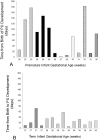Pressure ulcers in the hospitalized neonate: rates and risk factors
- PMID: 25502955
- PMCID: PMC5377020
- DOI: 10.1038/srep07429
Pressure ulcers in the hospitalized neonate: rates and risk factors
Abstract
Pressure ulcers (PU) are serious, reportable events causing pain, infection and prolonged hospitalization, particularly among critically ill patients. The literature on PUs in neonates is limited. The objective was to determine the etiology, severity and influence of gestational age on PUs among hospitalized infants. A two-year prospective study was conducted among 741 neonatal intensive care patients over 31,643 patient-days. Risk factors were determined by comparing the characteristics of infants who developed PUs with those who did not. There were 1.5 PUs per 1000 patient days with 1.0 PU per 1000 days in premature infants and 2.7 per 1000 days in term infants. The number of PUs associated with devices was nearly 80% overall and over 90% in premature infants. Infants with PUs had longer hospitalizations and weighed more than those who did not. Infants with device-related PUs were younger, of lower gestational age and developed the PU earlier than patients with PUs due to conventional pressure. The time to PU development was longer in prematurely born versus term infants. Hospitalized neonates are susceptible to device-related injury and the rate of stage II injury is high. Strategies for early detection and mitigation of device-related injury are essential to prevent PUs.
Conflict of interest statement
The authors declare no competing financial interests.
Figures

Similar articles
-
A quality-improvement collaborative project to reduce pressure ulcers in PICUs.Pediatrics. 2013 Jun;131(6):e1950-60. doi: 10.1542/peds.2012-1626. Epub 2013 May 6. Pediatrics. 2013. PMID: 23650292 Free PMC article.
-
Pressure ulcers' incidence, preventive measures, and risk factors in neonatal intensive care and intermediate care units.Int Wound J. 2018 Aug;15(4):571-579. doi: 10.1111/iwj.12900. Epub 2018 Jun 13. Int Wound J. 2018. PMID: 29897161 Free PMC article.
-
Pediatric pressure ulcer prevalence: a multicenter, cross-sectional, point prevalence study in Switzerland .Ostomy Wound Manage. 2012 Jul;58(7):18-31. Ostomy Wound Manage. 2012. PMID: 22798351
-
Are pressure redistribution surfaces or heel protection devices effective for preventing heel pressure ulcers?J Wound Ostomy Continence Nurs. 2009 Nov-Dec;36(6):602-8. doi: 10.1097/WON.0b013e3181be282f. J Wound Ostomy Continence Nurs. 2009. PMID: 19920740 Review.
-
A narrative review on pressure ulcer (PU) studies relevant to medical imaging.Pan Afr Med J. 2020 Jun 4;36:66. doi: 10.11604/pamj.2020.36.66.19431. eCollection 2020. Pan Afr Med J. 2020. PMID: 32754293 Free PMC article. Review.
Cited by
-
[Characteristics Influencing the Occurrence of Respiratory Medical Device-related Pressure Ulcers in the Pediatric Intensive Care Unit].Child Health Nurs Res. 2019 Apr;25(2):133-142. doi: 10.4094/chnr.2019.25.2.133. Epub 2019 Apr 30. Child Health Nurs Res. 2019. PMID: 35004406 Free PMC article. Korean.
-
Global variation in skin injures and skincare practices in extremely preterm infants.World J Pediatr. 2023 Feb;19(2):139-157. doi: 10.1007/s12519-022-00625-2. Epub 2022 Nov 13. World J Pediatr. 2023. PMID: 36372868 Free PMC article.
-
A rabbit model for assessment of volatile metabolite changes observed from skin: a pressure ulcer case study.J Breath Res. 2017 Jan 9;11(1):016007. doi: 10.1088/1752-7163/aa51d7. J Breath Res. 2017. PMID: 28068292 Free PMC article.
-
[Incidence of pressure injuries associated with oxygen therapy devices in the neonatal intensive care unit].Rev Esp Salud Publica. 2024 Apr 23;98:e202404032. Rev Esp Salud Publica. 2024. PMID: 38666583 Free PMC article. Spanish.
-
Measurement and Sequelae of Neonatal Skin Injuries: A Prospective Diagnostic/Feasibility Study.Int Wound J. 2025 Aug;22(8):e70745. doi: 10.1111/iwj.70745. Int Wound J. 2025. PMID: 40827056 Free PMC article.
References
-
- Schindler C. A., Mikhailov T. A., Fischer K., Lukasiewicz G., Kuhn E. M. et al. Skin integrity in critically ill and injured children. Am J Crit Care 16, 568–574 (2007). - PubMed
-
- Eichenfield L. F. & Hardaway C. A. Neonatal dermatology. Curr Opin Pediatr 11, 471–474 (1999). - PubMed
-
- Evans N. J. & Rutter N. Development of the epidermis in the newborn. Biol Neonate 49, 74–80 (1986). - PubMed
-
- Cartlidge P. The epidermal barrier. Semin Neonatol 5, 273–280 (2000). - PubMed
-
- Harpin V. A. & Rutter N. Barrier properties of the newborn infant's skin. J Pediatr 102, 419–425. (1983). - PubMed
MeSH terms
LinkOut - more resources
Full Text Sources
Other Literature Sources
Medical

